Related Research Articles

The Lumbricidae are a family of earthworms. About 33 lumbricid species have become naturalized around the world, but the bulk of the species are in the Holarctic region: from Canada and the United States and throughout Eurasia to Japan. An enigmatic species in Tasmania is Eophila eti. Currently, 670 valid species and subspecies in about 42 genera are recognized. This family includes the majority of earthworm species well known in Europe and Asia.

Oligochaeta is a subclass of soft-bodied animals in the phylum Annelida, which is made up of many types of aquatic and terrestrial worms, including all of the various earthworms. Specifically, oligochaetes comprise the terrestrial megadrile earthworms, and freshwater or semiterrestrial microdrile forms, including the tubificids, pot worms and ice worms (Enchytraeidae), blackworms (Lumbriculidae) and several interstitial marine worms.

In biology, a type is a particular specimen of an organism to which the scientific name of that organism is formally associated. In other words, a type is an example that serves to anchor or centralizes the defining features of that particular taxon. In older usage, a type was a taxon rather than a specimen.

Megascolecidae is a family of earthworms native to Madagascar, Australia, New Zealand, Asia, and North America. All species of the Megascolecidae belong to the Clitellata class. The Megascolecidae comprise a large family of earthworms and they can grow up to 2 meters in length. The intercontinental distribution of Megascolecidae species favours the continental drift theory.
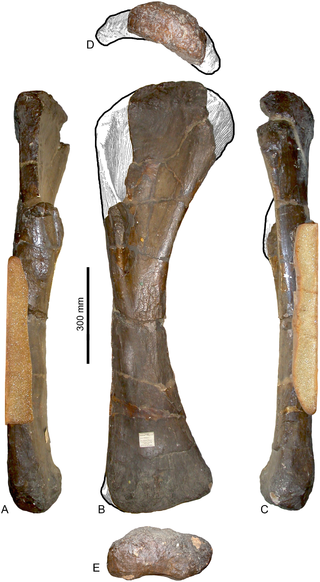
Pelorosaurus is a genus of titanosauriform sauropod dinosaur. Remains referred to Pelorosaurus date from the Early Cretaceous period, about 140-125 million years ago, and have been found in England and Portugal. Thomas Holtz estimated its length at 24 meters.
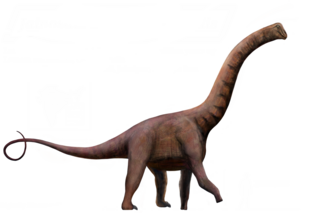
Jainosaurus is a genus of titanosaurian sauropod dinosaur of India and wider Asia, which lived in the Maastrichtian. It is thought to have been about the same size as its contemporary relative Isisaurus, measuring 18 metres (59 ft) long and weighing 15 metric tons. The humerus of the type specimen is 134 centimetres long.
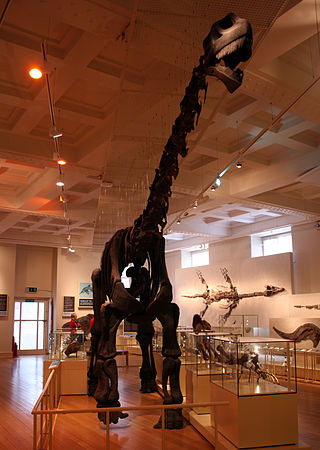
Cetiosaurus meaning 'whale lizard', from the Greek keteios/κήτειος meaning 'sea monster' and sauros/σαυρος meaning 'lizard', is a genus of herbivorous sauropod dinosaur from the Middle Jurassic Period, living about 168 million years ago in what is now Britain and probably France.

Monoclonius is an extinct genus of herbivorous ceratopsian dinosaur found in the Late Cretaceous layers of the Judith River Formation in Montana, United States, and the uppermost rock layers of the Dinosaur Park Formation in Alberta, Canada dated to between 75 and 74.6 million years ago.

Pipunculidae is a family of flies (Diptera) commonly termed big-headed flies, a reference to the large (holoptic) eyes, which cover nearly the entire head. The family is found worldwide and more than 1300 species have been described.
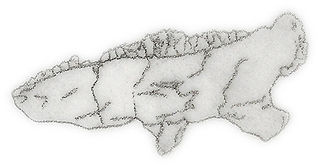
Tatisaurus is a genus of ornithischian dinosaur from the Early Jurassic from the Lower Lufeng Formation in Yunnan Province in China. Little is known as the remains are fragmentary. The type species is T. oehleri.

The Liberian mongoose is a mongoose species native to Liberia and Ivory Coast. It is the only member of the genus Liberiictis. Phylogenetic analysis shows it is closely related to other small, social mongooses and that the banded mongoose is its closest relative.

Mauisaurus is a dubious genus of plesiosaur that lived during the Late Cretaceous period in what is now New Zealand. Numerous specimens have been attributed to this genus in the past, but a 2017 paper restricts Mauisaurus to the lectotype and declares it a nomen dubium.
The Acanthodrilidae are an ancient and widely distributed family of earthworms which has native representatives in Australia, New Zealand, South Africa, South America, and North America. No native species are known from India nor Asia. The family possibly shows a pre-Pangaean distribution.

An earthworm is a soil-dwelling terrestrial invertebrate that belongs to the phylum Annelida. The term is the common name for the largest members of the class Oligochaeta. In classical systems, they were in the order of Opisthopora since the male pores opened posterior to the female pores, although the internal male segments are anterior to the female. Theoretical cladistic studies have placed them in the suborder Lumbricina of the order Haplotaxida, but this may change. Other slang names for earthworms include "dew-worm", "rainworm", "nightcrawler", and "angleworm". Larger terrestrial earthworms are also called megadriles as opposed to the microdriles in the semiaquatic families Tubificidae, Lumbricidae and Enchytraeidae. The megadriles are characterized by a distinct clitellum and a vascular system with true capillaries.

Austrocidaria parora is a species of moth of the family Geometridae. It is endemic to New Zealand.
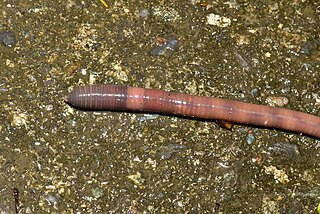
Amynthas is a genus of earthworms in the family Megascolecidae. They are known as jumping worms, snake worms, or crazy worms because of their erratic thrashing behaviour when disturbed. The genus is native to East Asia, but they are invasive in many areas of the United States. They are a matter of concern in many states, as they disrupt the native forest ecology by affecting soil structure and chemistry.

Buenaspis is a genus of small nektaspid arthropod, that lived during the early Cambrian period. Fossil remains of Buenaspis were collected from the Lower Cambrian Sirius Passet Lagerstätte of North Greenland. Buenaspis looks like a soft eyeless trilobite. It has a headshield slightly larger than the tailshield (pygidium), and in between them six thoracic body segments (somites). The genus is monotypic, its sole species being Buenaspis forteyi.
Samuel James is an American scientist, a researcher specializing in evolutionary biology, focusing on earthworm taxonomy. James, with fellow researchers, has discovered numerous species of annelids, including Diplocardia californiana, Diplocardia woodi, Diplocardia montana, and a new species related to the Giant Palouse earthworm.

Archimyrmex is an extinct genus of ant in the formicid subfamily Myrmeciinae, described by palaeoentomologist Theodore Cockerell in 1923. The genus contains four described species, Archimyrmex rostratus, Archimyrmex piatnitzkyi, Archimyrmex smekali and Archimyrmex wedmannae. Archimyrmex is known from a group of Middle Eocene fossils which were found in North America, South America, and Europe. The genus was initially placed in the subfamily Ponerinae, but it was later placed in Myrmeciinae; it is now believed to be the ancestor of the extant primitive genus Myrmecia from Australia. Despite this, Archimyrmex is not a member to any tribe and is regarded as incertae sedis within Myrmeciinae. However, some authors believe Archimyrmex should be assigned as incertae sedis within Formicidae. These ants can be characterised by their large mandibles and body length, ranging from 13.2 to 30 mm. They also have long, thin legs and an elongated mesosoma (thorax) and petiole.

Casaleia is an extinct genus of ants in the formicid subfamily Amblyoponinae described by Pagliano & Scaramozzino in 1990 from fossils found in Europe. The genus contains four species dating from the Eocene to Miocene, Casaleia eocenica, Casaleia inversa, Casaleia longiventris, Casaleia orientalis.
References
- ↑ "Family Microchaetidae Michaelsen, 1921". Texas A&M University . Retrieved April 4, 2010.
- ↑ The Guinness book of records 1997 edition page 70
- ↑ The Guinness book of records 1993 edition page 99
[1] Plisko, J. (2006). A systematic reassessment of the genus Microchaetus Rapp, 1849: its amended definition, reinstatement of Geogenia Kinberg, 1867, and erection of a new genus Kazimierzus (Oligochaeta: Microchaetidae). African Invertebrates, 47 (1). 31-56.
[2] Beddard, F. (1886a). On the anatomy and systematic position of a gigantic earthworm (Microchaeta rappi) from the Cape Colony. Transactions of the Zoological Society of London, 12 (1). 63-76.
[3] Beddard, "On the anatomy and systematic position of a gigantic earthworm (Microchaeta rappi) from the Cape Colony", p.64-65
[4] Plisko, "A systematic reassessment of the genus Microchaetus Rapp, 1849: its amended definition, reinstatement of Geogenia Kinberg, 1867, and erection of a new genus Kazimierzus (Oligochaeta: Microchaetidae)", p.31
[5] Beddard, "On the anatomy and systematic position of a gigantic earthworm (Microchaeta rappi) from the Cape Colony", p.63
[6] Plisko, "Designation of lectotypes for Microchaetus microchaetus (Rapp, 1849) and Microchaetus rappi Beddard, 1886, and historical perspectives on these species (Oligochaeta: Microchaetidae)", p.270
[7] Plisko, "A systematic reassessment of the genus Microchaetus Rapp, 1849: its amended definition, reinstatement of Geogenia Kinberg, 1867, and erection of a new genus Kazimierzus (Oligochaeta: Microchaetidae)", p.31
[8] Plisko, "Designation of lectotypes for Microchaetus microchaetus (Rapp, 1849) and Microchaetus rappi Beddard, 1886, and historical perspectives on these species (Oligochaeta: Microchaetidae)", p.270
[9] Plisko, "Designation of lectotypes for Microchaetus microchaetus (Rapp, 1849) and Microchaetus rappi Beddard, 1886, and historical perspectives on these species (Oligochaeta: Microchaetidae)", p.270
[10] Plisko, "A systematic reassessment of the genus Microchaetus Rapp, 1849: its amended definition, reinstatement of Geogenia Kinberg, 1867, and erection of a new genus Kazimierzus (Oligochaeta: Microchaetidae)", p.34-35
[11] Plisko, "A systematic reassessment of the genus Microchaetus Rapp, 1849: its amended definition, reinstatement of Geogenia Kinberg, 1867, and erection of a new genus Kazimierzus (Oligochaeta: Microchaetidae)", p.34-35
[12] Plisko, "A systematic reassessment of the genus Microchaetus Rapp, 1849: its amended definition, reinstatement of Geogenia Kinberg, 1867, and erection of a new genus Kazimierzus (Oligochaeta: Microchaetidae)", p.34
[13] Beddard, "On the anatomy and systematic position of a gigantic earthworm (Microchaeta rappi) from the Cape Colony", p.65
[14] Benham, W. (1886). Studies on Earthworms, Part II. Descriptions of New or Little-Known Earthworms. I. Microchaeta Rappi, Beddard (Lumbricus microchetus, Rapp). Quarterly Journal of Microscopical Science, 28 (1). p.267
[15] Benham, "Studies on Earthworms, Part II. Descriptions of New or Little-Known Earthworms. I. Microchaeta Rappi, Beddard (Lumbricus microchetus, Rapp)", p.268
[16] Plisko, "Designation of lectotypes for Microchaetus microchaetus (Rapp, 1849) and Microchaetus rappi Beddard, 1886, and historical perspectives on these species (Oligochaeta: Microchaetidae)", p.270
[17] Benham, "Studies on Earthworms, Part II. Descriptions of New or Little-Known Earthworms. I. Microchaeta Rappi, Beddard (Lumbricus microchetus, Rapp)", p.269
[18] Benham, "Studies on Earthworms, Part II. Descriptions of New or Little-Known Earthworms. I. Microchaeta Rappi, Beddard (Lumbricus microchetus, Rapp)", p.268
[19] Benham, "Studies on Earthworms, Part II. Descriptions of New or Little-Known Earthworms. I. Microchaeta Rappi, Beddard (Lumbricus microchetus, Rapp)", p.269
[20] Benham, "Studies on Earthworms, Part II. Descriptions of New or Little-Known Earthworms. I. Microchaeta Rappi, Beddard (Lumbricus microchetus, Rapp)", p.270
[21] Benham, "Studies on Earthworms, Part II. Descriptions of New or Little-Known Earthworms. I. Microchaeta Rappi, Beddard (Lumbricus microchetus, Rapp)", p.270
[22] Benham, "Studies on Earthworms, Part II. Descriptions of New or Little-Known Earthworms. I. Microchaeta Rappi, Beddard (Lumbricus microchetus, Rapp)", p.270
[23] Benham, "Studies on Earthworms, Part II. Descriptions of New or Little-Known Earthworms. I. Microchaeta Rappi, Beddard (Lumbricus microchetus, Rapp)", p.270
[24] Benham, "Studies on Earthworms, Part II. Descriptions of New or Little-Known Earthworms. I. Microchaeta Rappi, Beddard (Lumbricus microchetus, Rapp)", p.271
[25] Benham, "Studies on Earthworms, Part II. Descriptions of New or Little-Known Earthworms. I. Microchaeta Rappi, Beddard (Lumbricus microchetus, Rapp)", p.274
[26] Benham, "Studies on Earthworms, Part II. Descriptions of New or Little-Known Earthworms. I. Microchaeta Rappi, Beddard (Lumbricus microchetus, Rapp)", p.274
[27] Benham, "Studies on Earthworms, Part II. Descriptions of New or Little-Known Earthworms. I. Microchaeta Rappi, Beddard (Lumbricus microchetus, Rapp)", p.275
[28] Benham, "Studies on Earthworms, Part II. Descriptions of New or Little-Known Earthworms. I. Microchaeta Rappi, Beddard (Lumbricus microchetus, Rapp)", p.276
[29] Plisko, J. (2013). Notes on the status of the family Microchaetidae. Zoology in the Middle East58 (4). p.50
[30] Plisko, "Notes on the status of the family Microchaetidae", p.50
[31] Plisko, "Designation of lectotypes for Microchaetus microchaetus (Rapp, 1849) and Microchaetus rappi Beddard, 1886, and historical perspectives on these species (Oligochaeta: Microchaetidae)", p.269
[32] Plisko, "Designation of lectotypes for Microchaetus microchaetus (Rapp, 1849) and Microchaetus rappi Beddard, 1886, and historical perspectives on these species (Oligochaeta: Microchaetidae)", p.270
[33] Plisko, "Designation of lectotypes for Microchaetus microchaetus (Rapp, 1849) and Microchaetus rappi Beddard, 1886, and historical perspectives on these species (Oligochaeta: Microchaetidae)", p.271
[34] Plisko, "Designation of lectotypes for Microchaetus microchaetus (Rapp, 1849) and Microchaetus rappi Beddard, 1886, and historical perspectives on these species (Oligochaeta: Microchaetidae)", p.274
[1] Plisko, J. (2006). A systematic reassessment of the genus Microchaetus Rapp, 1849: its amended definition, reinstatement of Geogenia Kinberg, 1867, and erection of a new genus Kazimierzus (Oligochaeta: Microchaetidae). African Invertebrates, 47(1). 31-56.
[2] Beddard, F. (1886a). On the anatomy and systematic position of a gigantic earthworm (Microchaeta rappi) from the Cape Colony. Transactions of the Zoological Society of London, 12 (1). 63-76.
[3] Beddard, "On the anatomy and systematic position of a gigantic earthworm (Microchaeta rappi) from the Cape Colony", p.64-65
[4] Plisko, "A systematic reassessment of the genus Microchaetus Rapp, 1849: its amended definition, reinstatement of Geogenia Kinberg, 1867, and erection of a new genus Kazimierzus (Oligochaeta: Microchaetidae)", p.31
[5] Beddard, "On the anatomy and systematic position of a gigantic earthworm (Microchaeta rappi) from the Cape Colony", p.63
[6] Plisko, "Designation of lectotypes for Microchaetus microchaetus (Rapp, 1849) and Microchaetus rappi Beddard, 1886, and historical perspectives on these species (Oligochaeta: Microchaetidae)", p.270
[7] Plisko, "A systematic reassessment of the genus Microchaetus Rapp, 1849: its amended definition, reinstatement of Geogenia Kinberg, 1867, and erection of a new genus Kazimierzus (Oligochaeta: Microchaetidae)", p.31
[8] Plisko, "Designation of lectotypes for Microchaetus microchaetus (Rapp, 1849) and Microchaetus rappi Beddard, 1886, and historical perspectives on these species (Oligochaeta: Microchaetidae)", p.270
[9] Plisko, "Designation of lectotypes for Microchaetus microchaetus (Rapp, 1849) and Microchaetus rappi Beddard, 1886, and historical perspectives on these species (Oligochaeta: Microchaetidae)", p.270
[10] Beddard, "On the anatomy and systematic position of a gigantic earthworm (Microchaeta rappi) from the Cape Colony", p.65
[11] Benham, W. (1886). Studies on Earthworms, Part II. Descriptions of New or Little-Known Earthworms. I. Microchaeta Rappi, Beddard (Lumbricus microchetus, Rapp). Quarterly Journal of Microscopical Science, 28 (1). p.267
[12] Benham, "Studies on Earthworms, Part II. Descriptions of New or Little-Known Earthworms. I. Microchaeta Rappi, Beddard (Lumbricus microchetus, Rapp)", p.268
[13] Plisko, "Designation of lectotypes for Microchaetus microchaetus (Rapp, 1849) and Microchaetus rappi Beddard, 1886, and historical perspectives on these species (Oligochaeta: Microchaetidae)", p.270
[14] Benham, "Studies on Earthworms, Part II. Descriptions of New or Little-Known Earthworms. I. Microchaeta Rappi, Beddard (Lumbricus microchetus, Rapp)", p.269
[15] Benham, "Studies on Earthworms, Part II. Descriptions of New or Little-Known Earthworms. I. Microchaeta Rappi, Beddard (Lumbricus microchetus, Rapp)", p.268
[16] Benham, "Studies on Earthworms, Part II. Descriptions of New or Little-Known Earthworms. I. Microchaeta Rappi, Beddard (Lumbricus microchetus, Rapp)", p.269
[17] Benham, "Studies on Earthworms, Part II. Descriptions of New or Little-Known Earthworms. I. Microchaeta Rappi, Beddard (Lumbricus microchetus, Rapp)", p.270
[18] Plisko, J. (2013). Notes on the status of the family Microchaetidae. Zoology in the Middle East58 (4). p.50
[19] Plisko, "Notes on the status of the family Microchaetidae", p.50
[20] Plisko, "Designation of lectotypes for Microchaetus microchaetus (Rapp, 1849) and Microchaetus rappi Beddard, 1886, and historical perspectives on these species (Oligochaeta: Microchaetidae)", p.269
[21] Plisko, "Designation of lectotypes for Microchaetus microchaetus (Rapp, 1849) and Microchaetus rappi Beddard, 1886, and historical perspectives on these species (Oligochaeta: Microchaetidae)", p.270
[22] Plisko, "Designation of lectotypes for Microchaetus microchaetus (Rapp, 1849) and Microchaetus rappi Beddard, 1886, and historical perspectives on these species (Oligochaeta: Microchaetidae)", p.271
[23] Plisko, "Designation of lectotypes for Microchaetus microchaetus (Rapp, 1849) and Microchaetus rappi Beddard, 1886, and historical perspectives on these species (Oligochaeta: Microchaetidae)", p.274